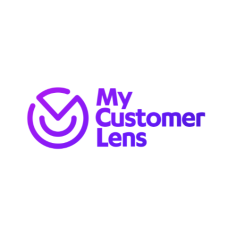Using AI to measure your brand promises with MyCustomerLens
Have you started using AI to measure your brand promises? Measuring your brand through annual research is no longer the best way to track progress. Client needs and expectations – not to mention the services delivered by your competitive alternatives – are evolving too quickly.
Client-focused firms are looking for a fresh and relevant flow of insights that can be delivered by proven AI algorithms to generate brand signals in real-time.
The future has arrived and it’s not knocking politely on the door, it’s kicking it down with a shiny AI boot! Say goodbye to guesswork and all the “maybes”, “possiblys” and “we’re pretty sures”. We’re stepping into the era of “we know”, thanks to the power of Artificial Intelligence.
The (Not So) Subtle Art of Promise Keeping
Across Marketing and BD teams, the conversation is turning to brand accountability. Clients and prospects are challenging firms to keep their brand promises and show how they are doing it. At the end of an engagement, clients are looking back at the shiny pitch decks and asking if firms really delivered on their promises.
- Did the range of experts paraded at the pitch, really come to the table?
- Was the firm’s approach genuinely and consistently innovative, or was fresh new thinking communicated in a letter addressed to Dear Sirs?
- Did they trumpet how client-focused they are, and then leave a communications void?
Clients are holding a mirror up to their trusted advisors. Is your firm ready for the truth revolution?!
If you have an always-on client listening platform, then the answer is yes.
AI has the power to transform how your firm makes, measures and keeps its brand promises. In part 1 of this article (law firm branding – do you walk the talk) we looked at the big picture stuff:
- What is your firm’s brand
- How clear are your brand promises
- 4 ways to think about measuring brand alignment
So now the rubber hits the road, and we look specifically at how you can start measuring your brand promises.
AI – Your New Truth Serum
The solution to this scrutiny is not to make your brand promises more vague – it’s to make them more explicit. Don’t join the chorus of firms saying they are client-focused. Instead show clients and prospects how you are client-focused. Show them how you deliver on your brand promises.
Doing this in a relevant and compelling way requires fresh and actionable insights, and AI can help you get them.
Re-discover the power of open questions
When professionals interview clients, they ask them open questions. They don’t put words into their mouth or restrict them to multiple-choice options. As a result, interviews can reveal rich insights within the unstructured text of a conversation. However, traditional client listening methods have either:
- Restricted the number of interviews so they only include top clients, and/or
- Not replicated the open questions within surveys because of the time and expense of manually analysing the text responses
Trusted AI algorithms, designed specifically for B2B use cases, have turned traditional client listening on its head. When actionable insights can be instantly generated from text responses, you no longer need to limit the formal and informal conversations you capture, nor do you need to limit your survey insights to tick box questions.
The future of brand promise measurement
From a brand measurement perspective, open questions are a gold mine. You can discover what clients – unprompted – see as your greatest strengths and weaknesses across the client journey. They have the space to explain in their own words how the brand makes them feel and where it stands out in comparison to the other firms that they use – spoiler alert, they’re comparing you to the other services in their life, not the other firms in your niche.
In other words, they can tell you if and when they feel like you keep your brand promises. After all, your brand is not created by what you do, but by how others feel about what you do.
Now you could argue that this is what your existing consulting/research agency does. They conduct interviews and manually analyse and report on what they heard.
But imagine a future where you could ask open questions of all your clients, and at multiple stages in the client journey.
Now imagine how agile your decision-making would be if you didn’t need to wait weeks for the transcripts to be sent through and for the PowerPoint reports to be finished. What if the insights were available the instant the conversation had finished, and you had the ability to immediately compare them to historical conversations or a summary from other clients in the same sector or practice area.
Industry-specific AI algorithms are driving the future of brand promise measurement and delivering early adopters a competitive advantage.
3 ways you can use AI to measure brand promises
Where NLP-based AI text analysis beats humans is in speed and consistency. The analysis is performed the same way every time – machines can look for thousands of different concepts and don’t get bored or distracted. Meanwhile large volumes of text that take humans days to analyse, are finished instantly.
So what can AI do for brand marketers?
Automatically measure the sentiment within client and prospect comments
For many years, tech products have been using AI to identify positive, neutral and negative comments. When comments are unprompted, sentiment analysis of individual sentences is a great way to identify the topics and issues that are creating an emotional reaction.
However, sometimes the sentiment is in the question (e.g. what do we do well). In this case the answer may be neutral, but AI can still surface the emotions that clients use to describe their experiences.
Discover what needs, actions and processes are driving that sentiment
Just knowing the sentiment of a comment is interesting, but not very actionable – it’s a bit like seeing an NPS score without knowing why they gave that rating. So our AI algorithms also identify the various topics people are talking about.
They could be very positive about their recent webinar, the friendliness of reception staff or the fresh thinking within a detailed piece of advice. These are all good things, but each insight would prompt a different action. Knowing which processes are driving sentiment is crucial to creating actionable insights and brand alignment.
Track whether their value drivers align with yours
The value drivers framework gives your analysis structure by enabling you to connect feedback to brand alignment. We developed the value drivers from analysing thousands of client comments and comparing them to how firms position themselves. As a result, the framework helps you compare brand promises with client reality.
Doing this with AI enables you to see through the smoke and mirrors and discover blind spots. For example, clients may rave about your firm’s responsiveness and expertise, but never mention you as innovative. This would go unnoticed by humans, who tend to look for positive and negative extremes. But what clients don’t say about your brand and client experience, can’t often be more insightful than what they do say!
How to get started today
Step 1 – identify your firm’s value drivers.
The 3-5 ways that your firm seeks to differentiate its client experience. While all the value drivers are important, you can’t be better than average at more than a few – and neither should you try. Creating a standout brand requires being clear about what you stand for, and equally what you don’t stand for. Being beige is not distinctive.
Step 2 – review your existing feedback data
go through your recent unstructured text comments from clients, and look for occurrences of each of the 10 value drivers. If you don’t yet have an always-on client listening platform, then you can do this manually using a 5-bar gate tally system or a rainbow of highlighter pens. See the links below to download a template.
Step 3 – look for areas of misalignment
Compare the volume of comments (or tally’s / highlighter marks) against your firm’s value drivers. Do the value drivers with the most marks match what your firm is seeking to stand-out for? Is there white space, where certain value drivers rarely get mentioned?
You now have your baseline, a visual representation of where your brand promises are being kept and broken. Using the AI within an always-on client listening platform will ensure that you always have the latest picture of your brand alignment. And the time you save manually analysing data can instead be used helping the business to more consistently deliver on its brand promises.



